The Germinator Blog
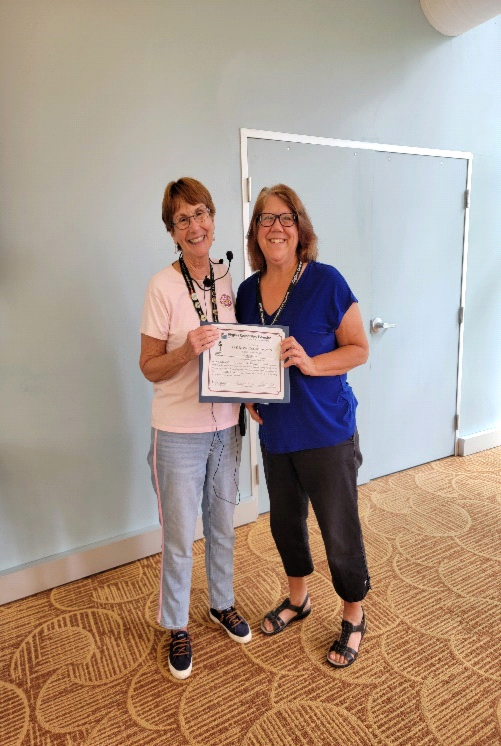
Cynthia was born in Detroit, Michigan, but due to her father’s job, lived in Louisiana, New Jersey, Indiana, and Ohio. She settled in Norfolk in August, 2023 based on family vacations in Virginia, and the fact that her parents lived in Virginia Beach for thirty-five years. Cynthia graduated from the University of Cincinnati, College of Engineering, Cincinnati, Ohio. Most of her adult life was spent in the Cincinnati area, Jacksonville, Florida, and Paducah, Kentucky. Cynthia is a retired Chemical Engineer who worked as Senior Process Engineer in Manufacturing and Research Design and Development in various industries (Vistacon Contact Lenses, Hilton Davis Copy Dyes and Pigments, Drackett household chemicals, Sabic plastics, and Uranium hexafluoride conversion). She enjoys growing flowers and vegetables and likes designing landscaping around her home, discovering what works and what doesn’t. She enjoys sharing her love for gardening with others and participating in fixer-upper landscaping. The classes reminded her of being in college where she enjoyed applying the information rather than simply appreciating the science behind it. She enjoyed working with her classmates, meeting other master gardeners and experts in the field, and learning about the Master Gardener projects. To attain her required fifty hours she worked at Weyanoke Bird and Wildlife Sanctuary, the Dune Garden, ECO garden, the spring plant sale, Propagation Palooza, and the Poplar Hall Park ERT event. Going forward she will continue volunteering at Weyanoke Bird and Wildlife Sanctuary, the ECO garden and other events that look interesting to her. Cynthia enjoys volunteering at the Norfolk Botanical Garden and helping with her church’s vegetable garden. She is active with a woman’s social group that has card games, seasonal parties, and events, such as going to the planetarium, a lavender field, and the Dismal Swamp. She would like to get back to day hiking. Cynthia is a first-time cat mama with two rescues, Yahtzee (brown/gray male tabby) and Feta (female gray/diluted-tortie shorthair). When you see Cynthia, be sure to introduce yourself and welcome her to the Norfolk Extension Master Gardeners.
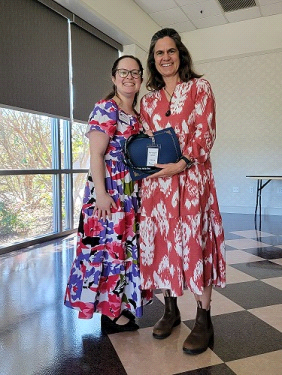
Pervaneh was born in Oban in the West Highlands of Scotland. Her family lived in a small village called Port Appin about twenty miles north on the shores of Loch Linnhe. She shares that from the middle of the loch on a clear day, you can see the top of Ben Nevis. She went to a local school until age ten. During those years she enjoyed riding her bike, being a Brownie, and Gaelic singing. She was then sent to England to attend boarding schools with her elder brothers and cousins. Pervaneh remembers that the boarding schools were extremely old fashioned in the 1980s and she felt she might have missed some opportunities during that time. She has a degree in psychology but was not happy in that field, so she decided to pursue a career in law. She had fun being a litigation solicitor in London but this became incompatible with motherhood. For the past ten years she has worked for Citizens Advice, a UK information charity set up post WW2 to ensure no one is disadvantaged due to lack of information or access to it, and to lobby for social justice. Pervaneh is in Norfolk with her husband, Tim, who is a lawyer in the British Army and here with NATO. Since his family is from Norfolk, England, they feel right at home! During the first month in our city, Pervaneh’s husband met a Norfolk Master Gardener who told him that the program was the best thing he had done in years. Pervaneh signed up for the classes immediately as she was missing her own small garden in the UK where she raised vegetables, raspberries, and tomatoes. In the September online information session, a comment was made that she lived close to the Fred Heutte Center and there she met Monica who was very generous with her time and expertise. She attended as many trial sessions as she could. She believes the program is fabulous and a golden opportunity for her to learn more about the unique area of Norfolk, which she calls the Venice of America! Pervaneh was “taken aback” when she saw the size of the textbook! The first chapter on botany seemed full of words with which she was not familiar. But she enjoyed attending the classes and felt the course was well structured. She enjoyed meeting all the people who were invested in the successful completion of the course, including her mentor. She liked the way classes were held at different locations because this provided an opportunity for her to get to know the city. Because she lives close to Weyanoke Bird and Wildflower Sanctuary and the Heutte Native Pollinator Garden, much of her required fifty hours were spent at those locations. She also participated in “beautification days” for the Elizabeth River Trail, Urban Ag, Zoo Cart, Significant Tree Project, and the Butterfly House at Norfolk Botanical Garden. She plans to continue working on these projects where she can admire the handiwork she has helped with and see how a gardened space can transform the experience of the city and people living there. Pervaneh enjoys tennis and traveling and she’s thinking that bonsai gardening might be fun. Her family consists of her husband, three children, and an “outdoorsy” cat who is currently living with her mother in the UK. When you see Pervaneh, be sure to introduce yourself and welcome her to the NMGA.
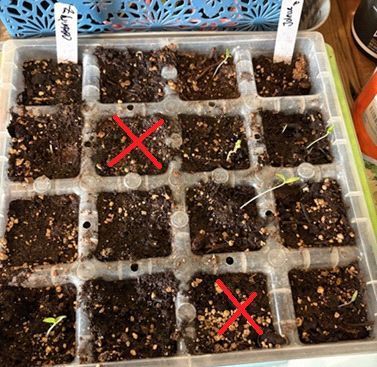
2025 VCE Home Vegetable Variety Trials: Tomatoes—Celebrity Plus vs. Jolene, Part 1 I had the opportunity to sign up for the VCE “Home Vegetable Variety Trials” in February of this year. My garden already had a lot of different plants, so I opted to try the tomato trials as they included two varieties that I hadn’t planned on growing: Celebrity Plus and Jolene. Both are determinate, which means the plants grow to a certain, smaller mature size, and then stop growing, versus indeterminate tomato plants, which grow, and grow more, and keep on growing, up to nine-foot vines! Part 1 covers from Feb to July 4th. (Look for a future post detailing the next few months’ progress.) What you get from VCE for the trials: • Seeds sent in lovely pre-labelled packages. I received seven seeds of each variety. • A lovely, printed questionnaire to track the germination and seed transplant dates, to track which seeds had better results, to track the first harvest, etc. I personally loved having a paper copy to keep specific notes on. Then in September, they will email a finalized questionnaire to complete and send notes back electronically. If you’re new to gardening, you’ll soon find out you’ll need a book, journal, Post-it notes, or some sort of note taking system. Most seasoned gardeners have a system which was usually spurred on by “what the heck happened” gardening moments. All seven of each variety’s seeds were planted on March 25th in trays, using potting soil; germination started on April 1st with five Jolenes and one Celebrity Plus.
Catherine “Cat” was born and grew up in a suburb of Philadelphia, PA. She shared that “every time I go home, I still get a cheesesteak!” Cat received her bachelor’s and master’s degrees from universities in the Philadelphia area, but received her doctorate in Miami, FL. She considers Miami a very fun city and very multi-cultural. She moved here because her husband was from Norfolk and they both love the beach. Her family had a beach home on Long Beach Island, NJ. Cat and her husband settled on Willoughby Spit and now she has a whole “beach family” here. She says that her back deck is a barbecue hub! Cat retired as a senior director from AstraZeneca in December 2023. She loved her work and supervised a dedicated group of professionals from many countries and cultures. She is currently an adjunct associate professor at UMGC. In addition, she has an antique space on the Eastern Shore. Cat always wanted to be a Master Gardener, but due to her work responsibilities, she knew she had to wait for retirement. She has always gardened, growing both vegetables and flowers. Her father was a gardener, and long before Doug Tallamy’s seminal book, her father dug up his suburban lawn to grow plants and vegetables, much to the chagrin of the neighborhood! She also wanted to be more involved in her new community and home. Cat loved the classes – the content, the instructors, the camaraderie of the class, and the food. She thought graduation was very special and believes that everyone is very welcoming at the various activities. To complete her internship, she volunteered at several Community Outreach events at the Hermitage Museum and Gardens, Pretlow Library, the Zoo, and the Navy Exchange. She also worked at the Fred Heutte Native Plant and Pollinator Garden and helped to plant the mermaid garden at Pretlow Library. She has also taken the classes to become a docent at the Norfolk Botanical Garden Butterfly House. She plans to continue participating in these projects, but also to continue to be open to new experiences. She would like to serve on a committee. When Cat isn’t involved in Norfolk Master Gardener projects, she has “many hobbies and so little time!” She experiments with hypertufa. She likes the fiber arts and has a spinning wheel and a marudai for kumihimo. Cat loves photography of plants and wildlife, and she crafts and “repurposes” for her antique space. Cat especially loves raising her Queen of the Night in the night-blooming cereus family, and the Queen has produced several blooms this year. She likes to select a few things each year that she has never grown before. This year it is seeds from the African Diaspora from Sista Seeds, and another Norfolk Master Gardener gave her lotus seeds, which are thriving! Cat lives with her husband, Keith. She visits her 90-year-old mother in Pennsylvania often. When in PA, they visit old friends and keep their membership at the beautiful Longwood Gardens. When you see Cat, be sure to introduce yourself and welcome her to the Norfolk Extension Master Gardeners.

I recently had the opportunity to give a tour of my garden to a lovely guest. As we strolled through the beds, I found myself talking about all the things that I obtained for free, or at very little cost. It occurred to me that some of the ideas might be useful to others who would like to garden "on the cheap." I have several ways to get the most bang for my buck for both plant material and garden "art." I am going to start with the plants, because they are my first love, and endless source of joy. The very first tip is to become a Norfolk Master Gardener (NMG), because you join a community of generous plant nuts who invite you to tour their gorgeous gardens, and invariably provide you with the loveliest parting gifts. My own garden is full of the examples of treasured favorites that were gifted to me by other Master Gardeners. My next suggestion is to volunteer to help your neighbors do their yard work. This fosters a bit of goodwill, and some free plants if your neighbors happen to be digging and dividing something you find interesting. Though a bit of caution on taking pass-along plants: they are sometimes vigorous little growers, and in the blink of an eye, you may find yourself, instead, as the giver of plants. Another way I have garnered plants for my yard is to ALWAYS talk plants EVERYWHERE I go. I talk about gardening as I walk through the neighborhood, at parties, and even in the line at the grocery store. You just never know who has something to share, like a perennial you have never seen before, or an envelope full of seeds that will color up your yard next spring. Speaking of seeds...even if you are not offered free ones, the investment in a seed packet or two at a big box store is a minimal expense. Yes, the seed thing requires a bit of patience (especially for perennials), but the "beauty on a budget" appeal is undeniable. In November I deploy seeds such as Poppies ( Papaver ), Larkspur ( Delphinium ), and Bachelor Buttons ( Centaurea cyanus ). In the spring they come to life and provide landing pads for my early pollinator guests. As spring blooms fade, I replace them with Cosmos ( Cosmos bipinnatus ) and Zinnia ( Zinnia elegans ) seedlings that I start indoors during March. Many of these annuals self-sow in the garden, and I harvest seeds from my plants in fall, so the investment in seeds has greatly reduced over the years. Shopping the many plant sales of local organizations such as Master Gardeners, Virginia Native Plant Society, and the Butterfly Society of Virginia have afforded me the opportunity to get many plants at a fraction of big box store prices. If you do shop the big box stores, the best time is at the end of the gardening season. They often have rolling racks of bedraggled looking perennial specimens that are way past their prime, but offered at deeply discounted prices. The only warning here is to check the foliage for insect pests, and tip them out of the pot to ensure the root system is still healthy.
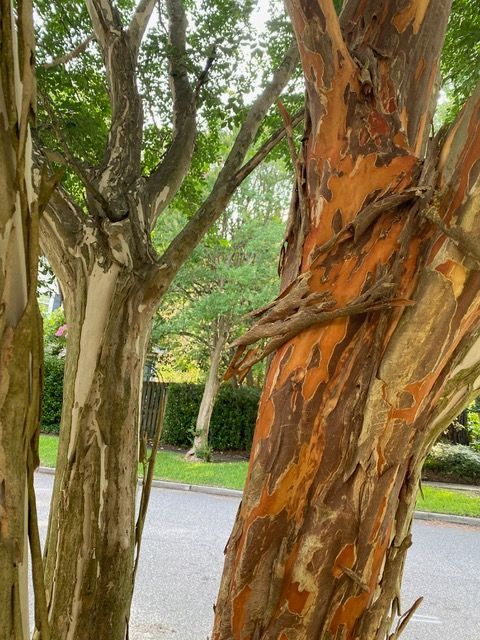
I have a love/hate relationship with the crape myrtles that dominate our Norfolk streetscapes. Love factor #1 : I am fascinated by crape myrtles’ bark-stripping show going on right now. Naturally peeling bark reveals swirls of cinnamon and tan-colored wood on trunks. Exfoliation seems early and excessive this year, which made me wonder if the bark shedding was triggered by our July weather, just like people shed extra layers in 90-degree weather. Apparently not, according to Dr. Gary R. Bachman of the Mississippi State University Extension Service. In an article, he calls crape myrtle bark exfoliation a natural process “accented in years when we’ve had excessive amounts of rain, as the outer bark expands in response to increased water uptake.” The National Weather Service reports a wetter than normal May and June for Norfolk. That may account for our current situation on my Larchmont street. Crape myrtles there look like a giant vegetable peeler has sliced away outer layers leaving piles of bark peelings. While it is tempting for people to pull bark from crape myrtles, Bachman warns against this. “You actually can harm the tree by exposing the inner bark before it’s physiologically hardened off,” he explains.
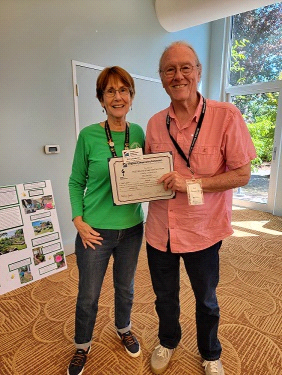
Bill was born in Chicago, Illinois, and grew up 150 miles southwest of Chicago, along the Mississippi River. He graduated from Monmouth College in Monmouth, Illinois in 1973 with a degree in Business Administration. A sojourn to Arkansas and Florida occupied the next 32 years, before moving to Norfolk. He retired in 2015 from his position as project manager for the City of Norfolk. He served as the City’s Americans with Disabilities Coordinator and administered the City’s ADA funding. His job included, among other things, administering industrial hygiene and abatement contracts. Bill led volunteers at the Primeplus Senior Center garden during COVID. He coordinated Master Gardeners, Navy, and Rotary volunteers in planting and maintaining a pollinator and cut flower garden, with an eye toward native plants. This experience sparked his interest in becoming a Norfolk Master Gardener. He thought the classes were very informative and were presented at a basic and easy-to-understand level. To achieve his fifty-hour requirement, Bill worked at the Weyanoke Bird and Wildlife Sanctuary, the Dig & Divide for the Plant Sale, the Significant Tree Project, the Fred Huette Pollinator and Native Plant Garden, Urban Ag home visits, the Elizabeth River Project Shoreline Restoration, seed packaging, and attended a Communications Committee meeting. He is working with Primeplus Senior Centers to build a new Pollinator and Native Plant garden at the Titustown Community Center on Diven Street. It will feature trellises, a gazebo which will double as an outdoor classroom, and a large rain barrel to promote water conservation. When Bill isn’t working on Norfolk Master Gardener projects, he serves on the Norfolk Commission for Persons with Disabilities, participates with the Rotary Club of Norfolk, and enjoys kayaking. Bill has three brothers, one in San Pacho, Nayarite, Mexico; one in Punta Gorda, Florida; and one in Cary, North Carolina. His stepdaughter lives in Virginia Beach. When you see Bill, be sure to give him a shout out and welcome him to the Norfolk Extension Master Gardeners.
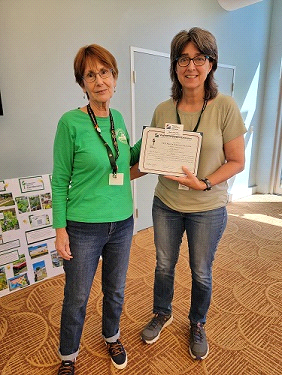
Beth is a Norfolk native but, as a child, moved with her family to Nova Scotia where her family originated. She returned to Norfolk where she graduated from ODU with a B.S. in Information Technology and Accounting, then passed the CPA exam. Her CPA license is in inactive status to pursue other interests in retirement. Beth worked as Director of Financial Systems for the Port of Virginia and was responsible for managing the port’s financial systems. She retired in January, 2025, after 20 years of service. Before working for the port, she held several accounting positions, including treasury supervisor for HQ/Hechinger/Builders Square and staff accountant for the Navy Lodge program at the Navy Exchange. Gardening has always been a part of Beth’s life. Growing up in rural Nova Scotia, everyone had a vegetable garden. Weeding the garden was a daily chore. Her father believed in living off the land as much as possible. Her grandmother was a member of the garden club and won ribbons for her plants. As an adult, Beth continues to garden and finds “digging in the dirt” very relaxing. Beth was impressed with how organized the classes were and the knowledge and education background of the guest speakers. The classes were very informative and the training team made it fun. She also enjoyed meeting and interacting with her classmates. Beth would like to thank Blanch Wise for taking time out of her day to volunteer as her mentor and new friend. To meet her fifty-hour requirement, Beth enjoyed working at the Children’s Garden at Ocean View, Weyanoke Bird and Wildlife Sanctuary, the Hermitage Museum and Gardens, and the Dune Garden. As a certified Master Gardener, she plans to continue participating in those projects. She notes that “there is always something to do at Weyanoke!” Beth likes to hike and kayak but she believes any outdoor activity is fun. She is looking forward to traveling more next year when Chris, her husband of 24 years, retires. Beth has been married for 24 years to her husband, Chris, who plans to retire in 2026. Her son is a Chief Warrant Officer 04 in the US Coast Guard and has two beautiful girls, ages 10 and 7. She spends all her vacation time chasing her son around the country to spend time with her grandkids. Her daughter has a career in Norfolk and also has two beautiful girls, ages 16 and 9. She is very involved with her daughters’ kids helping with homework, taking them on vacations, but mostly chauffeuring them to activities. When you see Beth, be sure to introduce yourself and welcome her to the Norfolk Extension Master Gardeners.
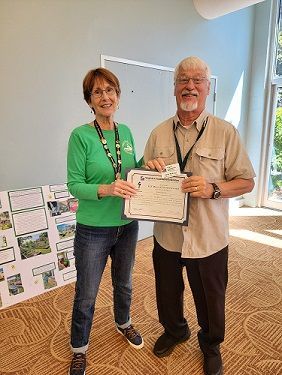
Keith is originally from a small, unincorporated village called Yorkfield located eleven miles west of Chicago. Keith describes his birthplace as “so small that the only person in Chicago that has ever heard of it is his oldest brother, because he moved there!” Originally the town was eight blocks long by two blocks wide. The western part of the village, where he grew up, was four blocks long by two blocks wide until annexation into Elmhurst. Keith went to elementary, junior high and high school in Elmhurst, the “big city of 55,000.” After school he joined the U.S. Navy and spent a lot of his enlistment in San Diego. He retired in Norfolk in 1994 as a non-destructive testing (NDT) of metals inspector. Following his retirement, Keith worked for the Johnathan Corporation in downtown Norfolk, and after the corporation’s closure, he became employed with NORSHIPCO (now BAE Systems, Norfolk Ship Repair) until he retired in early 2021. Keith wanted to become a Master Gardener to learn more about proper gardening methods as he believed he often gave his neighbors misinformation. He thought the classes were “great.” He was particularly impressed with the training team and their innate ability to overcome obstacles at a moment’s notice (e.g. snow, ice, and traffic, etc). To attain his fifty hours, Keith worked at the Fred Heutte Square Foot Garden, Weyanoke Bird and Wildlife Sanctuary, the Zoo Garden and the East Ocean View Children’s Garden. He wanted to get to all the NMG projects but it became difficult due to time constraints. Now that he is certified, he plans to continue with these projects as well as help with community involvement projects. Keith has completed his training at the Norfolk Botanical Garden, and looks forward to volunteering at the Butterfly House. Keith is the Sergeant-at-Arms at the American Legion, Second District of Virginia, Post 37. The organization provides a monthly food pantry for the community and maintains a lifetime commitment to our greater than 81,000 POWs and MIAs, to get their status for them, their families and friends. Keith’s family consists of his wife, six children (located in four states), one grandson, a Cavachon puppy and two pet rabbits that provide pellets for the Red Wigglers to eat in his compost. Each year one of the rabbits acts as the Easter Bunny for the egg hunt at the American Legion post. They are bashful but love attention. When you see Keith, be sure to give him a shout out and welcome him to the Norfolk Extension Master Gardeners.
Are you ready to become an author?
Send your article to the editorial board for the Germinator Blog.
(attach the article in .docx format and any image files)
Instructions to submit an article

